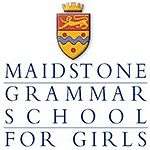Maidstone Grammar School for Girls
 | |
| Established | 1887 |
|---|---|
| Type | Foundation grammar school |
| Headteacher | Miss Deborah Stanley |
| Chairman of Governors | Mrs Molly Tipples (Deceased) |
| Location |
Buckland Road Maidstone Kent ME16 0SF England Coordinates: 51°16′48″N 0°30′43″E / 51.280°N 0.512°E |
| Local authority | Kent |
| DfE URN | 118836 Tables |
| Ofsted | Reports |
| Students | 1,252 |
| Gender | Girls (mixed sixth-form) |
| Ages | 11–18 |
| Website |
www |
Maidstone Grammar School for Girls, also known as Maidstone Girls Grammar School (MGGS), is a selective grammar school in Maidstone, UK. It operates under the 11-plus exam system, in which students take an exam at the end of primary school in order to be accepted at this school. The school is primarily a single sex girls school however it also incorporates a sixth form college which is mixed.
History
Maidstone Grammar School for Girls was founded in 1887 by the Wardens and Assistants of Rochester Bridge. It was originally located at Albion Place when it opened in January 1888 with 18 pupils. The current building was opened in Great Buckland in 1938. Additional buildings have since been added, including a large extension to the old building, and several separate blocks of classrooms and a large sports hall.
The school became a voluntary controlled grammar school since 1944, and it returned to the 11 plus entry examination in 1993.
In 2010 the school was given approval for a new building. Construction commenced in January 2011 and was planned to be completed by Christmas, however due to delays, it was officially opened in April 2012 for students. The new building, called Buckland house, houses sixth-form and Art and English departments, releasing space in the main building(s) for further expansion. A small, mobile building (known as a second N Block) has been said to be knocked down now that there are plenty of classrooms of better quality.
Rag Week
Rag week is entirely organised by the five Head Students. It runs in the last week before the Christmas term from Monday-Thursday. There is a fancy dress theme for around two different year groups a day, sometimes relating to the overall theme for Rag Week. This theme usually relates to the pantomime held twice during an extended Thursday lunchtime to allow lower school and upper school to see it. During Monday and Wednesday lunchtimes two different 20-minute shows are held, usually based on a television format such as 'X Factor' or 'Ads and Trailers'. Thursday lunchtime traditionally features two performances of Top of the Pops. These shows are all written by the year thirteen students and feature the staff in the central roles. Students will sometimes present the shows or take up minor roles such as dancers. After the panto, the students perform the "Rag Song" to the rest of the school. This is a popular song with lyrics relating to school life. Rag week often raises in excess of £4,000 and splits the funds raised between a local charity and a national charity, such as the Kent Air Ambulance Fund and the Make a Wish Foundation.
Houses
The school operates a house system consisting of six different houses; Vikings, Normans, Danes, Britons, Saxons and Romans. These houses compete in four annual competitions which encourage teamwork and team spirit and are a vibrant part of MGGS life. Perhaps the most popular competition is the House Arts Cup which takes place at the end of October. The event celebrates the arts of song, dance and acting and alternates between these each year. As well as House Arts the other competitions are Sports Day, Inter-house Rounders and Science Quiz. The houses are led by three year 13 students, who are elected into their role of House Leaders by their house.
From 2006, the House Captain election process, which had previously been decided entirely by votes from members of the house (both staff and students) was decided by interview as well as votes. It had been a worry that slightly 'impressionable' students might vote for popular male candidates over a more suitable candidate. Elections take place at the end of the second term before year thirteen students go on study leave. Every week, house captains organise an assembly on set topics, which often feature poems and stories relating to the theme.
House Cup
In 2007, the school introduced a new House Cup. The House Cup is awarded at the end of every academic year to the House with the most House Points. House points can be gained for academic success (merits and commendations) and also for inter-house competitions, including House Arts, Sports Day, the Science Quiz and many others.
The House leaderboard is displayed in reception.
House Arts
The House Arts competition takes place in October each year and is always based on one of three artistic divisions; drama, dance or music (generally in the form of choir), and is always on a particular theme that each performance must adhere to.
Notable former pupils
- Dame Karen Dunnell, National Statistician & Registrar-General, Office for National Statistics
- Mia Mckenna-Bruce,Young Actress,best known for her role as Tee Taylor in Tracy Beaker Returns and Penny Branning in Eastenders.
- Carole Goble, Professor of Computer Science at the University of Manchester
- Josh Zaré Model, professional dancer and Singer in the X factor 2013 in his band Kingsland
- Lizzy Yarnold Olympic skeleton racer who won gold in the 2014 Winter Olympics in Sochi